SKODA SUPERB 2007 1.G / (B5/3U) Owner's Manual
Manufacturer: SKODA, Model Year: 2007, Model line: SUPERB, Model: SKODA SUPERB 2007 1.G / (B5/3U)Pages: 259, PDF Size: 14.71 MB
Page 221 of 259
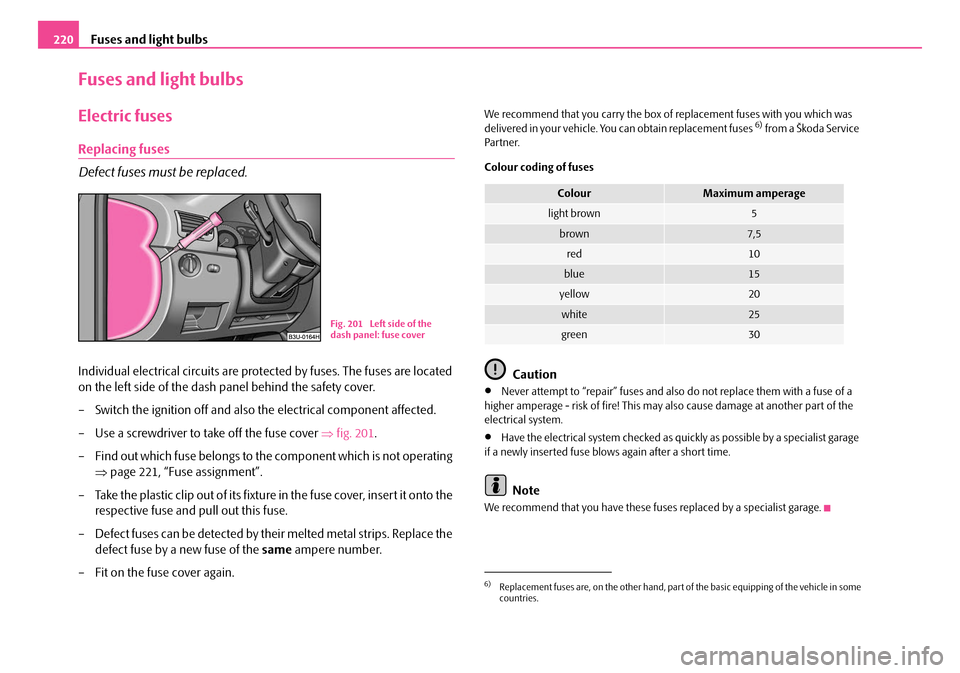
Fuses and light bulbs
220
Fuses and light bulbs
Electric fuses
Replacing fuses
Defect fuses must be replaced.
Individual electrical circuits are prot ected by fuses. The fuses are located
on the left side of the dash panel behind the safety cover.
– Switch the ignition off and also the electrical component affected.
– Use a screwdriver to take off the fuse cover ⇒fig. 201 .
– Find out which fuse belongs to the component which is not operating ⇒page 221, “Fuse assignment”.
– Take the plastic clip out of its fixture in the fuse cover, insert it onto the respective fuse and pull out this fuse.
– Defect fuses can be detected by their melted metal strips. Replace the defect fuse by a new fuse of the same ampere number.
–Fit on the fuse cover again.
We recommend that you carry the box of replacement fuses with you which was
delivered in your vehicle. You can obtain replacement fuses 6) from a Škoda Service
Par tner.
Colour coding of fuses
Caution
•Never attempt to “repair” fuses and also do not replace them with a fuse of a
higher amperage - risk of fire! This may also cause damage at another part of the
electrical system.
•Have the electrical system checked as quickly as possible by a specialist garage
if a newly inserted fuse blows again after a short time.
Note
We recommend that you have these fuses replaced by a specialist garage.
B1Z-0042HB1Z-0042HFig. 201 Left side of the
dash panel: fuse cover
6)Replacement fuses are, on the other hand, part of the basic equipping of the vehicle in some
countries.
ColourMaximum amperage
light brown5
brown7,5
red10
blue15
yellow20
white25
green30
NKO B5 20.book Page 220 Friday, March 2, 2007 1:46 PM
Page 222 of 259
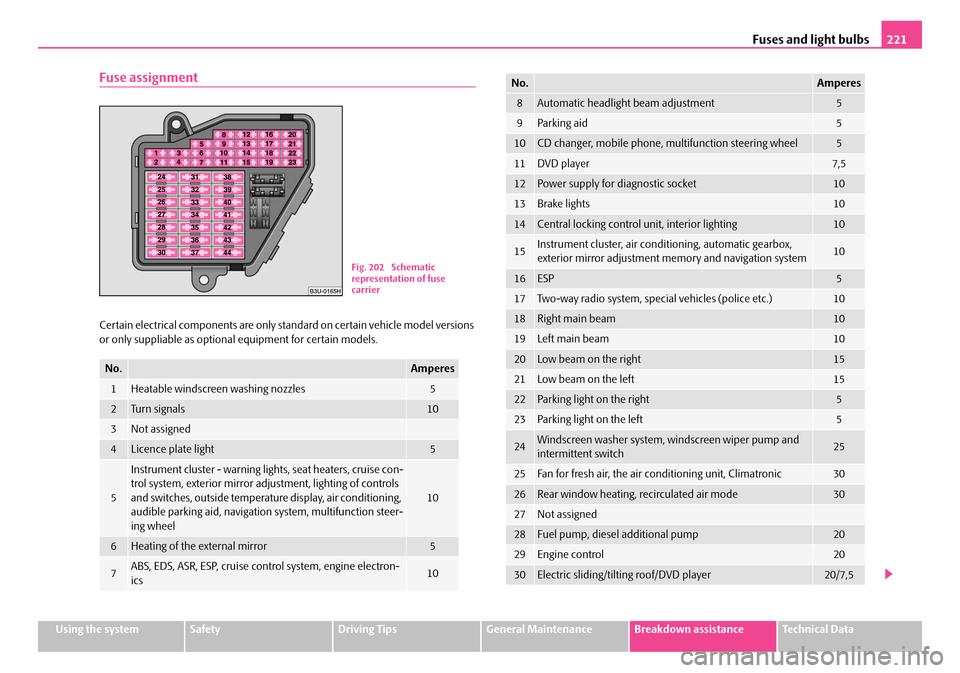
Fuses and light bulbs221
Using the systemSafetyDriving TipsGeneral MaintenanceBreakdown assistanceTechnical Data
Fuse assignment
Certain electrical components are only standard on certain vehicle model versions
or only suppliable as optional equipment for certain models.
No.Amperes
1Heatable windscreen washing nozzles5
2Tu r n s i g n a l s10
3Not assigned
4Licence plate light5
5
Instrument cluster - warning ligh ts, seat heaters, cruise con-
trol system, exterior mirror ad justment, lighting of controls
and switches, outside temperature display, air conditioning,
audible parking aid, navigation system, multifunction steer-
ing wheel
10
6Heating of the external mirror5
7ABS, EDS, ASR, ESP, cruise co ntrol system, engine electron-
ics10
Fig. 202 Schematic
representation of fuse
carrier
8Automatic headlight beam adjustment5
9Parking aid5
10CD changer, mobile phone, multifunction steering wheel5
11DVD player7,5
12Power supply for diagnostic socket10
13Brake lights10
14Central locking control unit, interior lighting10
15Instrument cluster, air cond itioning, automatic gearbox,
exterior mirror adjustment memory and navigation system10
16ESP5
17Two-way radio system, special vehicles (police etc.)10
18Right main beam10
19Left main beam10
20Low beam on the right15
21Low beam on the left15
22Parking light on the right5
23Parking light on the left5
24Windscreen washer system, windscreen wiper pump and
intermittent switch25
25Fan for fresh air, the air co nditioning unit, Climatronic30
26Rear window heating, recirculated air mode30
27Not assigned
28Fuel pump, diesel additional pump20
29Engine control20
30Electric sliding/tilting roof/DVD player20/7,5
No.Amperes
NKO B5 20.book Page 221 Friday, March 2, 2007 1:46 PM
Page 223 of 259
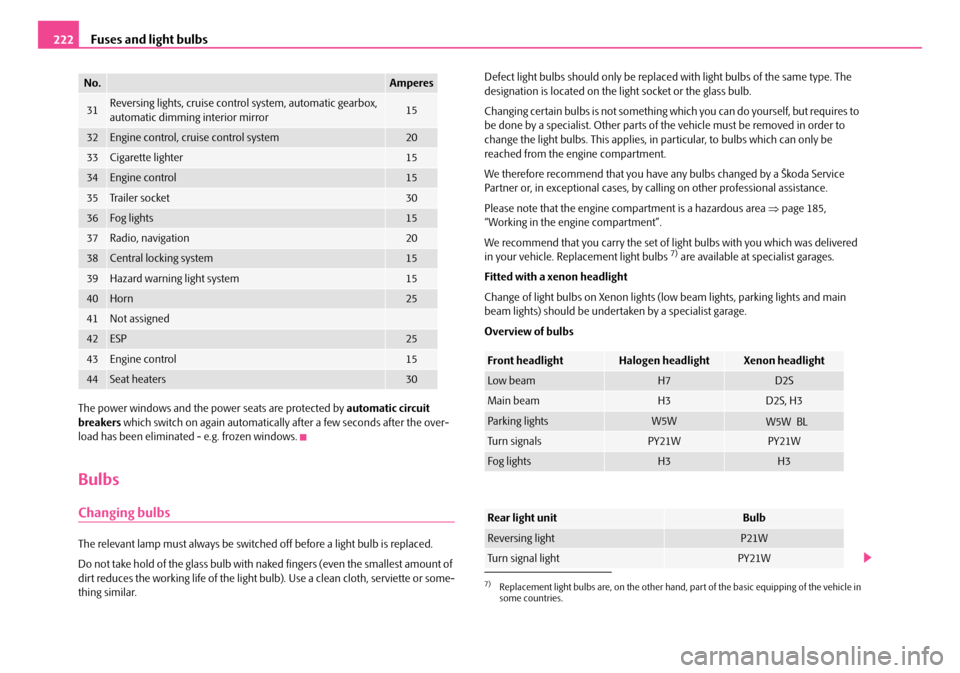
Fuses and light bulbs
222
The power windows and the power seats are protected by automatic circuit
breakers which switch on again automatically after a few seconds after the over-
load has been eliminated - e.g. frozen windows.
Bulbs
Changing bulbs
The relevant lamp must always be switch ed off before a light bulb is replaced.
Do not take hold of the glass bulb with naked fingers (even the smallest amount of
dirt reduces the working life of the light bu lb). Use a clean cloth, serviette or some-
thing similar. Defect light bulbs should only be replaced
with light bulbs of the same type. The
designation is located on the li ght socket or the glass bulb.
Changing certain bulbs is not something wh ich you can do yourself, but requires to
be done by a specialist. Other parts of the vehicle must be removed in order to
change the light bulbs. This applies, in particular, to bulbs which can only be
reached from the engine compartment.
We therefore recommend that you have any bulbs changed by a Škoda Service
Partner or, in exceptional cases, by ca lling on other professional assistance.
Please note that the engine compartment is a hazardous area ⇒page 185,
“Working in the engine compartment”.
We recommend that you carry the set of light bulbs with you which was delivered
in your vehicle. Replacement light bulbs
7) are available at specialist garages.
Fitted with a xenon headlight
Change of light bulbs on Xenon lights (low beam lights, parking lights and main
beam lights) should be undertaken by a specialist garage.
Overview of bulbs
31Reversing lights, cruise control system, automatic gearbox,
automatic dimming interior mirror15
32Engine control, cruise control system20
33Cigarette lighter15
34Engine control15
35Tr a i l e r s o c k e t30
36Fog lights15
37Radio, navigation20
38Central locking system15
39Hazard warning light system15
40Horn25
41Not assigned
42ESP25
43Engine control15
44Seat heaters30
No.Amperes
7)Replacement light bulbs are, on the other hand, part of the basic equipping of the vehicle in
some countries.
Front headlightHalogen headlightXenon headlight
Low beamH7D2S
Main beamH3D2S, H3
Parking lightsW5W
Tu r n s i g n a l sPY21WPY21W
Fog lightsH3H3
Rear light unitBulb
Reversing lightP21W
Turn signal lightPY21W
NKO B5 20.book Page 222 Friday, March 2, 2007 1:46 PM
W5W L
B
Page 224 of 259
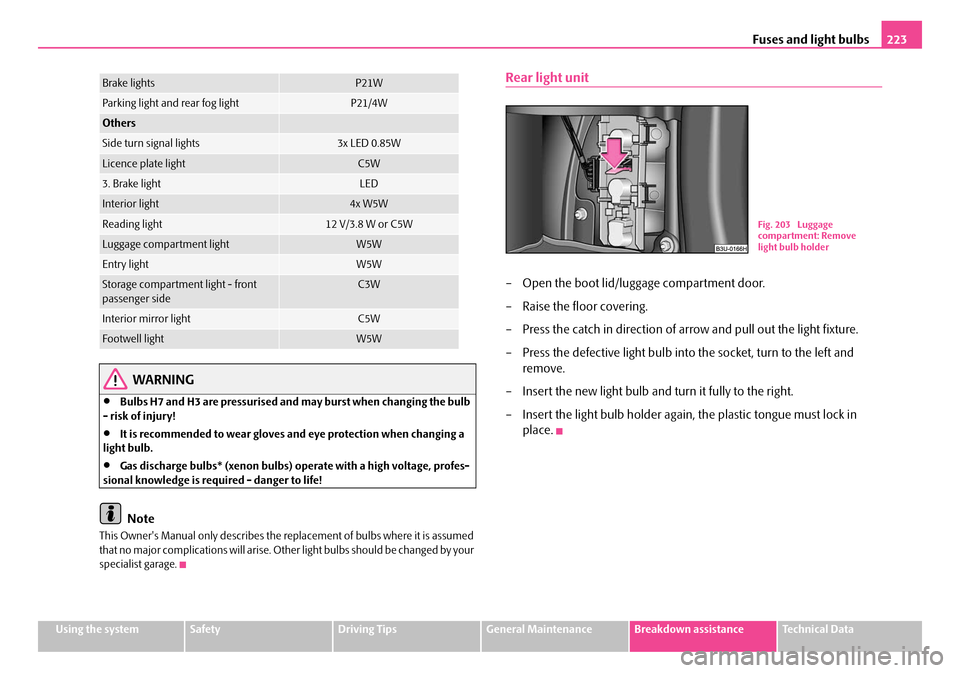
Fuses and light bulbs223
Using the systemSafetyDriving TipsGeneral MaintenanceBreakdown assistanceTechnical Data
WARNING
•Bulbs H7 and H3 are pressurised and may burst when changing the bulb
- risk of injury!
•It is recommended to wear gloves and eye protection when changing a
light bulb.
•Gas discharge bulbs* (xenon bulbs) operate with a high voltage, profes-
sional knowledge is required - danger to life!
Note
This Owner's Manual only describes the replacement of bulbs where it is assumed
that no major complications will arise. Other light bulbs should be changed by your
specialist garage.
Rear light unit
– Open the boot lid/luggage compartment door.
– Raise the floor covering.
– Press the catch in direction of arrow and pull out the light fixture.
– Press the defective light bulb into the socket, turn to the left and remove.
– Insert the new light bulb and turn it fully to the right.
– Insert the light bulb holder again, the plastic tongue must lock in place.
Brake lightsP21W
Parking light and rear fog lightP21/4W
Others
Side turn signal lights3x LED 0.85W
Licence plate lightC5W
3. Brake lightLED
Interior light4x W5W
Reading light12 V/3.8 W or C5W
Luggage compartment lightW5W
Entry lightW5W
Storage compartment light - front
passenger sideC3W
Interior mirror lightC5W
Footwell lightW5W
B1Z-0042HB1Z-0042H
Fig. 203 Luggage
compartment: Remove
light bulb holder
NKO B5 20.book Page 223 Friday, March 2, 2007 1:46 PM
Page 225 of 259

Fuses and light bulbs
224
Licence plate light
– Open the boot lid/luggage compartment door.
– Unscrew the glass cover of the light ⇒fig. 204 .
– Take the faulty bulb out of the fixture and insert a new one.
– Replace the the glass cover of the light and press it down to the stop - ensure that the glass cover is correctly installed.
– Screw the glass cover tight.
Luggage compartment light
– Insert a small screwdriver into the slot next to the light ⇒fig. 205 and
carefully press out the light.
– Unplug the connector.
– Take the faulty bulb out of the fixture and insert a new one.
–Plug in plug.
– Insert the light first of all on the side opposite the arrow and press it in carefully - until it locks in place.
B1Z-0042HB1Z-0042H
Fig. 204 Luggage
compartment door
Licence plate light
B1Z-0042HB1Z-0042HFig. 205 Luggage
compartment: Lighting
NKO B5 20.book Page 224 Friday, March 2, 2007 1:46 PM
Page 226 of 259

Fuses and light bulbs225
Using the systemSafetyDriving TipsGeneral MaintenanceBreakdown assistanceTechnical Data
Interior lights at the front
Changing the bulb for interior light of vehicles without an electric
sliding/tilting roof
– Insert a small screwdriver into the slot next to the light ⇒fig. 206 .
– Carefully press out the light and remove it from the headliner.
– Take the faulty bulb out of and insert a new one.
– First of all place the lights in the mounts at the rear and press them into
the headliner, until they lock into place. Changing the bulb for interior light of vehicles with an electric
sliding/tilting roof
– Position a small screwdriver carefully against the rear edge of the
cover of the power roof drive - arrows 1- ⇒fig. 207 .
– Lever off the cover down carefully.
– Insert a small screwdriver into the slot next to the light - arrow 2-.
– Carefully press out the light and remove it from the headliner.
– Take the faulty bulb out of and insert a new one.
– First of all place the lights in th e side plastic mounts and press them
upwards, until they lock into place.
– Press on the cover again by first of all inserting the plastic lugs and then pushing the cover up.
Interior lights at the rear
Changing the bulb for lights without interior monitoring sensors
– Insert a small screwdriver into th e slot next to the light cover
⇒ fig. 208 and carefully lever the cover off.
B1Z-0042HB1Z-0042H
Fig. 206 Interior lights at
the front for vehicles
without an electric
sliding/tilting roof
B1Z-0042HB1Z-0042H
Fig. 207 Interior lights at
the front for vehicles with
an electric sliding/tilting
roof
B1Z-0042HB1Z-0042H
Fig. 208 The interior
light at the rear without
interior monitoring
sensors
NKO B5 20.book Page 225 Friday, March 2, 2007 1:46 PM
Page 227 of 259

Fuses and light bulbs
226
– Take the faulty bulb out of and insert a new one.
– Insert the cover and press it in fully until it locks in place.
Changing the bulb for lights with interior monitoring sensors
– We recommend having the light bulbs replaced by a Škoda Service Par tner.
Lighting in storage compartment on front passenger side
– Insert a small screwdriver into the slot next to the light ⇒fig. 209 and
carefully lever out the light in the direction of the arrow .
– Unplug the connector.
– Take the faulty bulb out of and insert a new one.
–Plug in plug.
– Insert the light and press it into the wall of the storage compartment.
Entry lighting
– Insert a small screwdriver into the slot next to the light ⇒fig. 210 and
carefully lever out the light.
–Unplug plug .
– Push away the spring clip on the cover and remove the cover.
– Take the faulty bulb out of and insert a new one.
– Insert the cover again and secure it by locking it in place.
–Plug in plug.
– Insert the light from the rear and press it forwards up to the stop.
B1Z-0042HB1Z-0042HFig. 209 Storage
compartment: Lighting
A1
B1Z-0042HB1Z-0042HF i g . 2 1 0 I n n e r p a r t o f t h e
door: Entry light
A1
A2
NKO B5 20.book Page 226 Friday, March 2, 2007 1:46 PM
Page 228 of 259
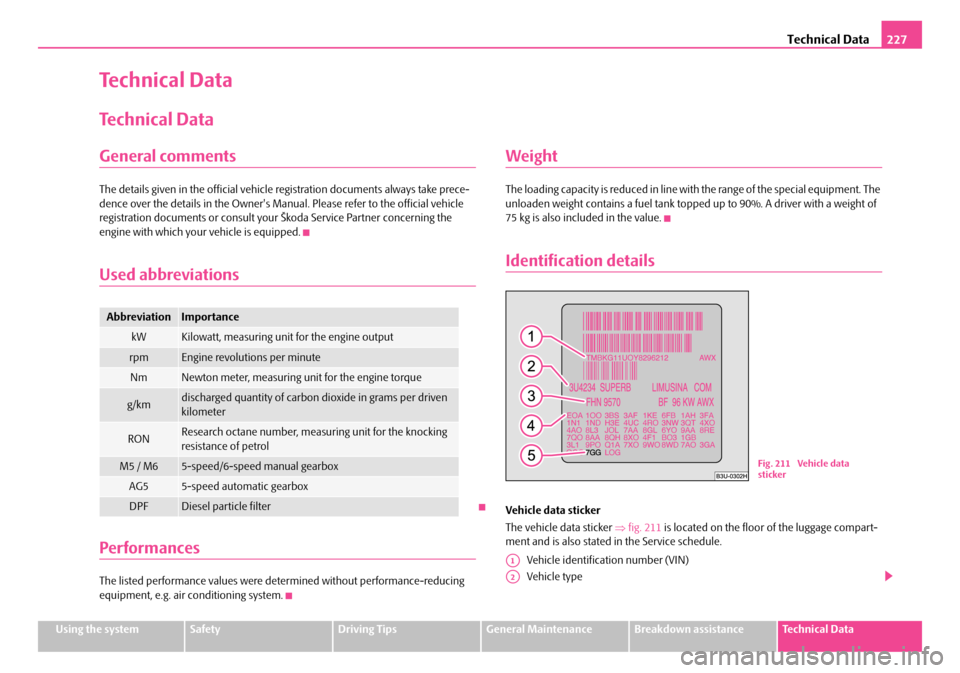
Technical Data227
Using the systemSafetyDriving TipsGeneral MaintenanceBreakdown assistanceTechnical Data
Technical Data
Technical Data
General comments
The details given in the official vehicle registration documents always take prece-
dence over the details in th e Owner's Manual. Please refer to the official vehicle
registration documents or consult your Škoda Service Partner concerning the
engine with which your vehicle is equipped.
Used abbreviations
Performances
The listed performance values were determined without performance-reducing
equipment, e.g. air conditioning system.
Weight
The loading capacity is reduced in line with the range of the special equipment. The
unloaden weight contains a fuel tank topped up to 90%. A driver with a weight of
75 kg is also included in the value.
Identification details
Vehicle data sticker
The vehicle data sticker ⇒fig. 211 is located on the floor of the luggage compart-
ment and is also stated in the Service schedule.
Vehicle identificati on number (VIN)
Vehicle type
AbbreviationImportance
kWKilowatt, measuring unit for the engine output
rpmEngine revolutions per minute
NmNewton meter, measuring un it for the engine torque
g/kmdischarged quantity of carbon dioxide in grams per driven
kilometer
RONResearch octane number, meas uring unit for the knocking
resistance of petrol
M5 / M65-speed/6-speed manual gearbox
AG55-speed automatic gearbox
DPFDiesel particle filter
Fig. 211 Vehicle data
sticker
A1
A2
NKO B5 20.book Page 227 Friday, March 2, 2007 1:46 PM
Page 229 of 259
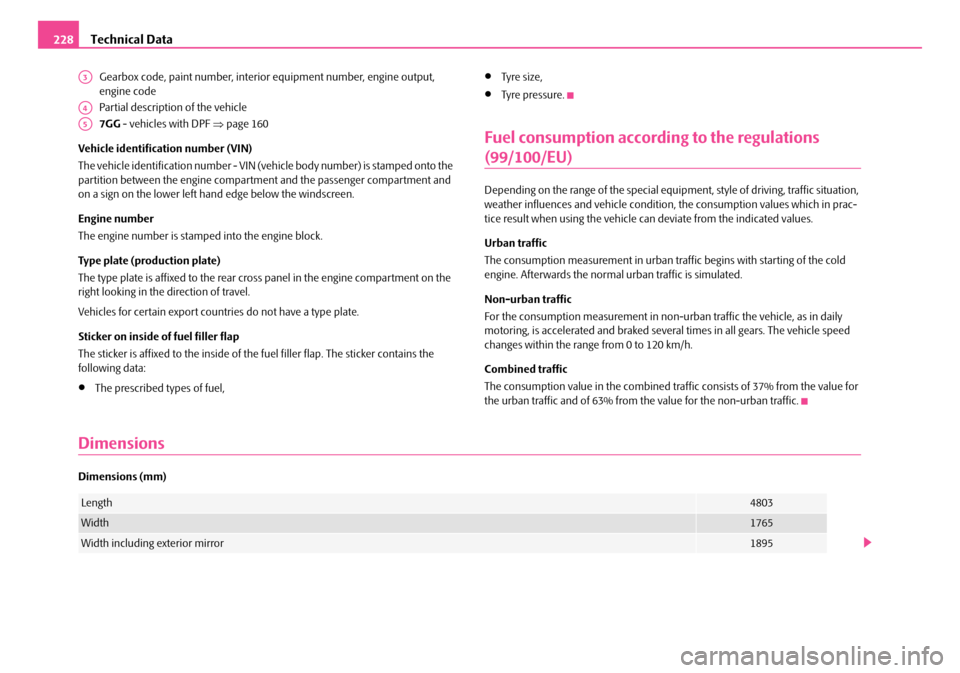
Technical Data
228
Gearbox code, paint number, interior equipment number, engine output,
engine code
Partial description of the vehicle
7GG - vehicles with DPF ⇒page 160
Vehicle identification number (VIN)
The vehicle identification number - VIN (v ehicle body number) is stamped onto the
partition between the engine compartment and the passenger compartment and
on a sign on the lower left hand edge below the windscreen.
Engine number
The engine number is stamped into the engine block.
Type plate (production plate)
The type plate is affixed to the rear cross panel in the engine compartment on the
right looking in the direction of travel.
Vehicles for certain export countries do not have a type plate.
Sticker on inside of fuel filler flap
The sticker is affixed to the inside of the fuel filler flap. The sticker contains the
following data:
•The prescribed types of fuel,
•Tyre s iz e ,
•Tyre pressure.
Fuel consumption according to the regulations
(99/100/EU)
Depending on the range of the special equipment, style of driving, traffic situation,
weather influences and vehi cle condition, the consumption values which in prac-
tice result when using the vehicle ca n deviate from the indicated values.
Urban traffic
The consumption measurement in urban traf fic begins with starting of the cold
engine. Afterwards the normal urban traffic is simulated.
Non-urban traffic
For the consumption measurement in non-ur ban traffic the vehicle, as in daily
motoring, is accelerated and braked several times in all gears. The vehicle speed
changes within the range from 0 to 120 km/h.
Combined traffic
The consumption value in the combined traf fic consists of 37% from the value for
the urban traffic and of 63% from the value for the non-urban traffic.
Dimensions
Dimensions (mm)
A3
A4
A5
Length4803
Width1765
Width including exterior mirror1895
NKO B5 20.book Page 228 Friday, March 2, 2007 1:46 PM
Page 230 of 259

Technical Data229
Using the systemSafetyDriving TipsGeneral MaintenanceBreakdown assistanceTechnical Data
Height
1469
1489a)
1449b)
Wheel base2803
Tr a c k g a u g e f r o n t / r e a r1521/1514
a)The value is valid for vehicles with rough road package.b)The value is valid for vehi cles with sport chassis
NKO B5 20.book Page 229 Friday, March 2, 2007 1:46 PM